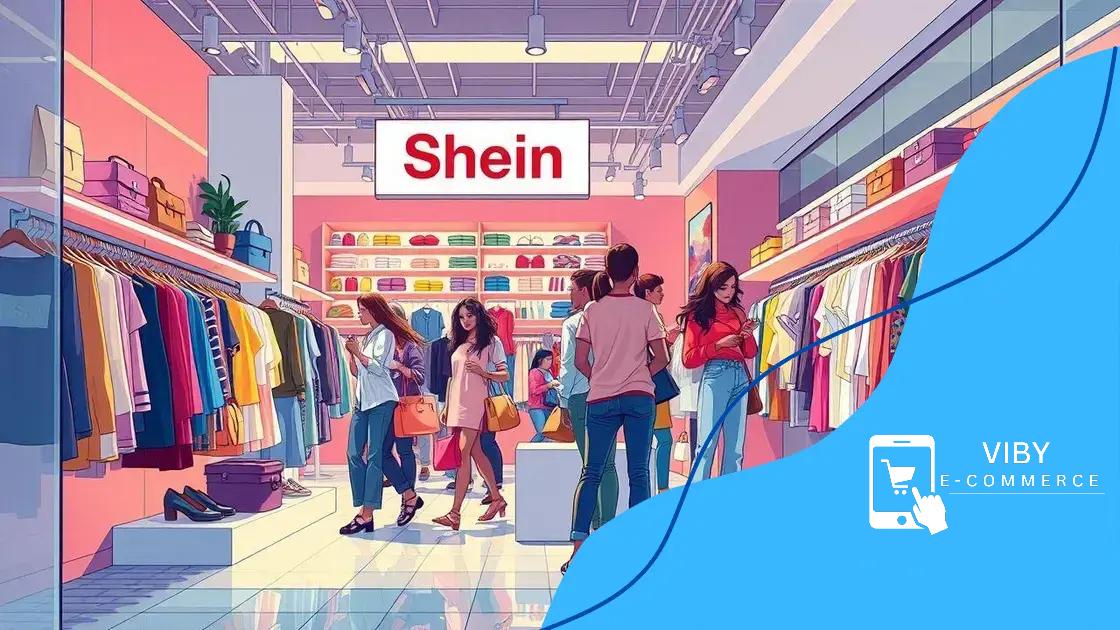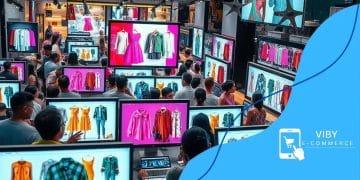Shein’s stock market impact on fast fashion

Shein’s stock market impact on fast fashion is profound, influencing consumer behavior, prompting sustainability concerns, and driving innovations in technology and shopping experiences in the evolving fashion landscape.
Shein’s stock market impact on fast fashion is not just a trend; it’s a game changer. Have you noticed how quickly fashion moves these days? Let’s dive into how this brand shapes the industry and our shopping habits.
The rise of Shein in the fast fashion industry
Shein has emerged as a dominant force in the fast fashion industry, bringing about a significant shift in how consumers shop. With its lightning-fast production cycle and trendy offerings, it has captured the attention of shoppers globally. But what factors contributed to this rapid rise?
Key Factors Driving Shein’s Success
One major aspect of Shein’s success lies in its innovative business model. By utilizing data analytics, the brand quickly identifies fashion trends and responds with new styles. This has allowed Shein to remain relevant and appealing to its target audience. In addition to its speedy production, the company employs a unique marketing strategy, focusing on social media influencers and user-generated content.
- Data-driven design processes
- Collaborations with social media influencers
- Affordable pricing strategy
- Fast shipping options for customers
Moreover, Shein’s ability to produce low-cost garments attracts a diverse customer base, especially younger shoppers looking for budget-friendly options. The brand’s interactive shopping experience, including quizzes and personalized recommendations, enhances customer engagement.
As Shein continues to grow, it also faces challenges, such as sustainability concerns and increasing competition from other fast fashion retailers. However, its adaptability and innovation in marketing strategies keep it at the forefront of the industry.
Consumer Response to Shein
The response from consumers has been overwhelmingly positive, thanks to Shein’s ability to cater to the latest trends at an affordable price. This appeal has led to a loyal customer base that eagerly shares their fashion finds on social media platforms. This phenomenon not only boosts Shein’s visibility but also creates a community around the brand.
Despite potential criticisms regarding sustainability, many shoppers prioritize style and price. This underscores a significant shift in consumer behavior, where trends often outweigh ethical considerations. The question remains—how will Shein adapt to changing consumer values in the future?
How Shein influences stock market trends
Shein not only impacts the fashion world but also plays a significant role in stock market trends. One way it influences the market is through its rapid growth, which attracts investor attention. As Shein expands its customer base and sales, investors look at its potential for profitability, leading to increased stock interest in partners and competitors.
The Link Between Sales and Stock Performance
Higher sales figures at Shein often translate to market excitement. When the company reports strong earnings, it can uplift the entire fast fashion sector. Other companies may experience a boost in their stock prices as investors hope to benefit from Shein’s popularity. This creates a ripple effect in the market.
- Shein’s annual sales growth numbers
- Stock price movements of related fashion retailers
- Market analysts’ reports on consumer trends
- The influence of social media mentions on investor sentiment
Furthermore, Shein’s innovative practices, such as embracing technology in retail, encourage traditional companies to adapt. This push for innovation affects how investors view the stock market. Investors start to favor tech-driven business models within the fashion industry, leading to a shift in investment strategies.
Stock market analysts keep a close eye on Shein’s performance, as its sales and marketing strategies could become benchmarks for others. With many consumers flocking to Shein for trendy items, its influence can dictate market trends that resonate beyond fast fashion. This connection makes it essential for stakeholders to monitor Shein’s activities closely.
Market Sentiment and Shein’s Branding
The way Shein brands itself also plays a crucial role in influencing market sentiment. Their savvy use of digital marketing and influencer partnerships creates a buzz that not only attracts buyers but also intrigues investors. The brand’s ability to stay relevant keeps its stock at the forefront of consideration for many investors.
In conclusion, the correlation between Shein’s operations and stock market dynamics emphasizes its status as a formidable player in both industries.
Consumer behavior changes due to Shein’s practices

Consumer behavior changes have become evident as a direct result of Shein’s innovative practices. The way shoppers interact with fashion has evolved, largely influenced by the brand’s marketing strategies and product offerings. One significant change is the shift towards a fast-paced shopping experience, where consumers expect immediate access to the latest trends.
Embracing Online Shopping
Shein has capitalized on the digital marketplace, making online shopping not only convenient but also highly engaging. With user-friendly apps and websites, shoppers can browse a vast selection of items in just a few clicks. This shift encourages impulse buying, as consumers are tempted by limited-time offers and frequent sales.
- Increased reliance on mobile shopping
- Popularity of flash sales and discount codes
- Engagement through social media platforms
- Personalized shopping experiences based on user data
Moreover, the use of social media influencers plays a crucial role in shaping consumer preferences. When popular figures endorse Shein’s products, their followers often take immediate action, resulting in quick purchasing decisions. This type of marketing not only builds brand loyalty but also affects the way consumers perceive value in fashion.
Another noticeable behavior change is the growing appetite for variety. Shein continually updates its inventory with new styles, attracting shoppers who crave fresh fashion choices. This has led consumers to buy more items more frequently, challenging traditional notions of clothing longevity and sustainability.
The Influence of Sustainability Concerns
While Shein’s rapid production model appeals to many, it has also ignited discussions about sustainability. As consumers become more aware of environmental issues, some express concern over fast fashion’s impact. Despite this, many still prioritize affordability over ethical considerations, creating a complex dynamic in consumer behavior.
This duality highlights a shift in priorities, as consumers navigate between seeking trendy items and understanding the consequences of their choices. Ultimately, Shein’s practices have transformed not just what consumers buy, but how they approach fashion shopping as a whole.
Sustainability concerns around Shein’s business model
Sustainability concerns have become a hot topic in the conversation surrounding Shein’s business model. As a leading player in the fast fashion industry, Shein’s practices raise questions about the environmental and social impacts of its rapid production cycle. Many consumers are becoming increasingly aware of these issues and are demanding more responsible practices from brands.
The Environmental Impact of Fast Fashion
The fast fashion model, which Shein embraces, often leads to excessive waste and pollution. Clothing is mass-produced at a rapid pace, which can contribute to significant environmental damage. The use of synthetic materials, like polyester, increases the carbon footprint of garments.
- High levels of textile waste generated
- Use of non-biodegradable materials
- Water consumption and pollution in manufacturing
- Carbon emissions from shipping and distribution
Moreover, Shein frequently releases new products, prompting consumers to buy more and discard old clothes rapidly. This cycle of consumption not only contributes to landfill waste but also reflects a more significant issue within the fashion industry.
Social Responsibility Considerations
In addition to environmental concerns, Shein faces criticism regarding its labor practices. Reports about working conditions in factories and the wages of workers can raise ethical questions for consumers. The company needs to navigate these challenges carefully to maintain its image and customer loyalty.
As shoppers become more conscious of their purchasing choices, brands like Shein are challenged to show transparency in their practices. By adopting sustainable materials and ethical labor practices, companies can address consumer concerns and potentially drive positive change in the industry.
Ultimately, while Shein’s fast fashion appeal is undeniable, the sustainability issues surrounding its business model present a complex dialogue between consumer demand and ethical responsibility.
Future outlook for fast fashion after Shein
The future outlook for fast fashion after Shein suggests a transformation in how brands operate. As consumers become more aware of sustainability and ethical practices, the industry may need to shift its focus. The rise of Shein has undoubtedly influenced fast fashion dynamics, but it also highlights the potential for change.
Emerging Trends in Fast Fashion
One major trend is the integration of technology into the shopping experience. With the success of Shein’s mobile app and online platform, other companies may follow suit, enhancing digital shopping options. This change can provide consumers with personalized experiences that cater to their preferences.
- Adoption of virtual fitting rooms
- Artificial intelligence for personalized recommendations
- Increased use of social media for marketing
- Collaborations with influencers for product launches
Additionally, many fast fashion brands may start emphasizing sustainable practices to attract conscious consumers. This could include using recycled materials, reducing waste, and improving labor conditions. As a result, companies could potentially reduce their environmental impact while appealing to a broader audience.
The Role of Consumer Awareness
As awareness around fast fashion practices grows, consumers are likely to demand more transparency. Brands may need to disclose their production processes and sourcing methods to gain trust and build loyalty. This shift in consumer expectations could lead to a more accountable fashion industry.
Ultimately, the landscape of fast fashion will continue to evolve after Shein. Brands that adapt to changing consumer demands for sustainability and technology will likely thrive. Those that fail to recognize these shifts may struggle to compete in this fast-paced market.
FAQ – Questions about Shein and the Future of Fast Fashion
How has Shein influenced consumer behavior in fast fashion?
Shein has changed consumer behavior by promoting a fast-paced shopping experience that encourages impulse buying and greater frequency in purchases.
What sustainability concerns surround Shein’s practices?
Shein’s rapid production model raises issues like excessive waste, use of non-biodegradable materials, and concerns about labor conditions in factories.
What trends can we expect in fast fashion after Shein?
Future trends may include an increased focus on sustainability, the integration of advanced technology in shopping experiences, and greater transparency from brands.
How can brands remain competitive in the evolving fast fashion market?
Brands can stay competitive by adopting sustainable practices, enhancing their digital presence, and responding to consumer demands for positive change.





